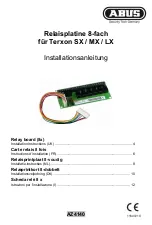
Disturbance recorder transfer verification
The IEC 60870-5-103 disturbance recorder file transfer implemented in the IED
has been verified by a third party client software. ABB does not provide any client
systems or evaluation tools for IEC 60870-5-103 disturbance data contents.
3.6
Non-standard features
The IEC 60870-5-103 protocol is defined for a single-function protection device
with limited set of functionalities. Problem that arises in a multiple functionality
IED are mainly related to the larger amount of Class 1 events typically generated
during a fault. Modern multifunctional IEDs may create up to 20-40 times more
events during a fault compared to single function devices that were the basis for the
IEC 60870-5-103 standard. IEC 60870-5-103 has some limitations:
•
The protocol is defined to be used on serial interfaces (max. allowed baud rate
19200 bauds).
•
The protocol can only transfer one change event per Class 1 poll.
•
Unbalanced communication: the master must poll all IEDs in the network
cyclically which means that the master cannot remain polling out events from
a certain IED for a very long time, since this degrades the overall response
time from the whole substation.
RE_615 includes some possibilities to fasten up and optimize the IEC 60870-5-103
communication. However, it is necessary to verify that these features are accepted
by the network and the IEC 60870-5-103 master used.
•
Remove unnecessary Class 1 objects. Even if the IED can provide a lot of
valuable information, it is not feasible to send everything on slower serial links.
•
Remove falling edge events for selected Class 1 objects.
•
Serial communication speed can be increased up to 115.2 kbauds. However,
observe that all IED’s on a multidrop link must support the same
communication speed.
•
GI data optimization which means that not all data is sent as GI data in a GI cycle.
3.6.1
GI optimization
The master should initiate a GI always after the IED has reported a Class 1 event
buffer overflow. The IED starts then to send GI data through the Class 1 event
buffer. As the standard defines, new events always have higher send priority than
GI data in the IED’s Class 1 buffer. The standard also defines that all data that are
subject to GI is sent by the IED.
Optimization of GI data is a non-standard feature. As default the
Optimize GI n
parameter (located via LHMI path
Configuration/Communication/IEC
60870-5-103/GI Optimize n
) is set to "Standard behaviour", meaning that the GI
Section 3
1MRS756710 C
Vendor-specific implementation
24
615 series
Communication Protocol Manual
Содержание Relion 615 series
Страница 1: ...Relion Protection and Control 615 series IEC 60870 5 103 Communication Protocol Manual...
Страница 2: ......
Страница 14: ...8...
Страница 32: ...26...
Страница 39: ...33...











































